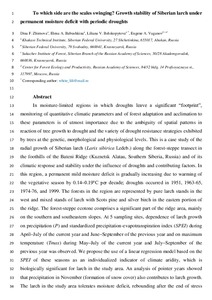Показать сокращенную информацию
To which side are the scales swinging? Growth stability of Siberian larch under permanent moisture deficit with periodic droughts
| Автор | Zhirnova, D. F. | |
| Автор | Babushkina, E. A. | |
| Автор | Belokopytova, L. V. | |
| Автор | Vaganov, E. A. | |
| Дата внесения | 2021-08-13T09:34:58Z | |
| Дата, когда ресурс стал доступен | 2021-08-13T09:34:58Z | |
| Дата публикации | 2020-03 | |
| Библиографическое описание | Zhirnova, D. F. To which side are the scales swinging? Growth stability of Siberian larch under permanent moisture deficit with periodic droughts [Текст] / D. F. Zhirnova, E. A. Babushkina, L. V. Belokopytova, E. A. Vaganov // Forest Ecology and Management. — 2020. — Т. 459. — С. 117841 | |
| ISSN | 03781127 | |
| URI (для ссылок/цитирований) | https://www.sciencedirect.com/science/article/pii/S0378112719320377 | |
| URI (для ссылок/цитирований) | https://elib.sfu-kras.ru/handle/2311/143121 | |
| Аннотация | In moisture-limited regions in which droughts leave a significant “footprint”, monitoring of quantitative climatic parameters and of forest adaptation and acclimation to these parameters is of utmost importance due to the ambiguity of spatial patterns in reaction of tree growth to drought and the variety of drought resistance strategies exhibited by trees at the genetic, morphological and physiological levels. This is a case study of the radial growth of Siberian larch (Larix sibirica Ledeb.) along the forest-steppe transect in the foothills of the Bateni Ridge (Kuznetsk Alatau, Southern Siberia, Russia) and of its climatic response and stability under the influence of droughts and contributing factors. In this region, a permanent mild moisture deficit is gradually increasing due to warming of the vegetative season by 0.14–0.19 °C per decade; droughts occurred in 1951, 1963–65, 1974–76, and 1999. The forests in the region are represented by pure larch stands in the west and mixed stands of larch with Scots pine and silver birch in the eastern portion of the ridge. The forest-steppe ecotone comprises a significant part of the ridge area, mainly on the southern and southeastern slopes. At 5 sampling sites, dependence of larch growth on precipitation (P) and standardized precipitation-evapotranspiration index (SPEI) during April–July of the current year and June–September of the previous year and on maximum temperature (Tmax) during May–July of the current year and July–September of the previous year was observed. We propose the use of a linear regression model based on the SPEI of these seasons as an individualized indicator of climate aridity, which is biologically significant for larch in the study area. An analysis of pointer years showed that precipitation in November (formation of snow cover) also contributes to larch growth. The larch in the study area tolerates moisture deficit, rebounding after the end of stress exposure. The spatiotemporal patterns of the stability indices revealed that despite the decrease in growth resistance and resilience with drought severity, these characteristics are higher at more arid sites due to trees’ acclimation to permanent climate aridity. The findings contribute to a better understanding of the capability of larch to further acclimatize and provide a basis for planning measures for conservation and/or restoration of the region’s forests under climate warming; however, to clarify the contributions of factors at the individual and local scales, further investigation of the stability of larch growth at the level of individual trees may be required. | |
| Тема | Radial growth | |
| Тема | Larix sibirica | |
| Тема | Kuznetsk Alatau | |
| Тема | Forest-steppe | |
| Тема | Climate–growth relationships | |
| Тема | Pointer years | |
| Тема | Drought stress | |
| Название | To which side are the scales swinging? Growth stability of Siberian larch under permanent moisture deficit with periodic droughts | |
| Тип | Journal Article | |
| Тип | Journal Article Preprint | |
| Страницы | 117841 | |
| Дата обновления | 2021-08-13T09:34:57Z | |
| DOI | 10.1016/j.foreco.2019.117841 | |
| Институт | Хакасский технический институт — филиал СФУ | |
| Подразделение | Научно-образовательная лаборатория "Дендроэкология и экологический мониторинг" | |
| Подразделение | Кафедра строительства | |
| Журнал | Forest Ecology and Management | |
| Квартиль журнала в Scopus | Q1 | |
| Квартиль журнала в Web of Science | Q1 |

